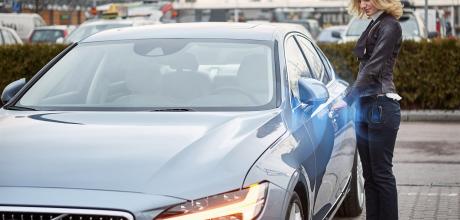First production car with a digital key 2016 Volvo S90 & XC90
Fishing in your trouser pocket for the keys to your car is probably one of the most Pavlovian things you can do but in terms of automotive tech history, the time between that shiny amalgam of shaped metal, plastic-tasting fresh air and the engine rumbling to life has branched out into some of the most innovative developments in the industry. Keys have played a part in vehicle security since the beginning of the 20th century and were essentially used as part of a physical locking mechanism for the crank ignition systems of the time. It was only in 1949 that Chrysler made a single-sided key that could play a role in activating the ignition system, albeit with the aid of a push-button.
THE INNOVATORS The cars we drive today were influenced by these pioneers
The car key remained largely unchanged for more than 15 years, until the engineers at Ford figured out that, for the sake of both convenience and security, a double-sided key would be an ideal solution. It’s a development that endures to this day. Much as electronics began to find their way into our home lives, their application in production vehicles birthed a wealth of new access and ignition technologies; from encoded keys linked to immobiliser systems and lasercut keys – cut to finer tolerances and more secure than physically ground keys – to infrared remote unlocking and proximity-based fobs and cards that enable the driver to walk up, pull the door handle and start the ignition with the key still in their pocket. The next big step in car key technology would, ironically, involve ditching physical keys altogether … and what better replacement than the ultimate indispensable tech item, the smartphone.
In 2016,Volvo unveiled the first production-series digital key system for its S90 and XC90 models. Utilising a combination of your smartphone’s Bluetooth, GPS and a proprietary application, the digital key unlocks the vehicle via proximity sensors and can initiate the ignition system. This system also opened up numerous other services to improve user convenience; instead of having to hand keys to another person collecting your vehicle, users can send an access code to approved and app-equipped phones, allowing others to use the vehicle.
Similarly, the digital key can work in conjunction with compatible car-hire systems; users can book and pay for a hire car anywhere in the world, using their smartphone. On arrival at the hire company’s lot, their phone’s GPS locates the vehicle, unlocks it and they drive away…
As with many emerging technologies, uptake has proven sporadic with viable concerns surrounding security and reliability. Even so, luxury manufacturers such as Mercedes-Benz, BMW and Tesla are among the growing number that are offering similar access technologies for some of their higher-tier models. In many cases, should the app fail or your smartphone battery run out, there’s a guaranteed failsafe… a good, old physical key to bail you out.
THEY ALSO PAVED THE WAY
1965 FORD THUNDERBIRD
The T’bird was one of the first cars to feature a double-sided ignition key. This not only proved more secure and difficult to clone, but took the guesswork out of which way the key should slot into the ignition.
1990 LEXUS LS400
The LS400’s laser-cut key featured a rectangular spine into which a unique track was cut on either side. This fine-tolerance approach to key-cutting made it difficult to replicate keys without specialist equipment.
1993 CHEVROLET CORVETTE
Although it couldn’t start the car’s ignition, the Corvette’s Passive Keyless Entry System unlocked the doors using a proximity sensor in the key fob. The systemdid drain the battery if the keys were left close to the car for any length of time, though.
2003 MERCEDES-BENZ S-CLASS W220/C215
The S-Class was the first car to feature a proximity fob that could unlock and start the car. The credit card-sized fob proved unreliable and prone to failures if subjected to high temperatures, water or impacts.


